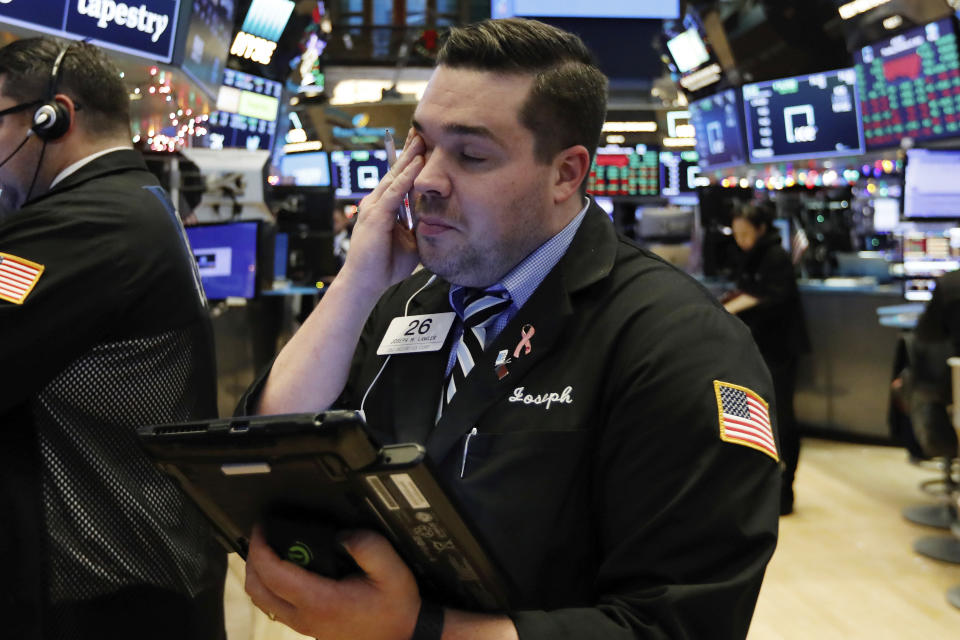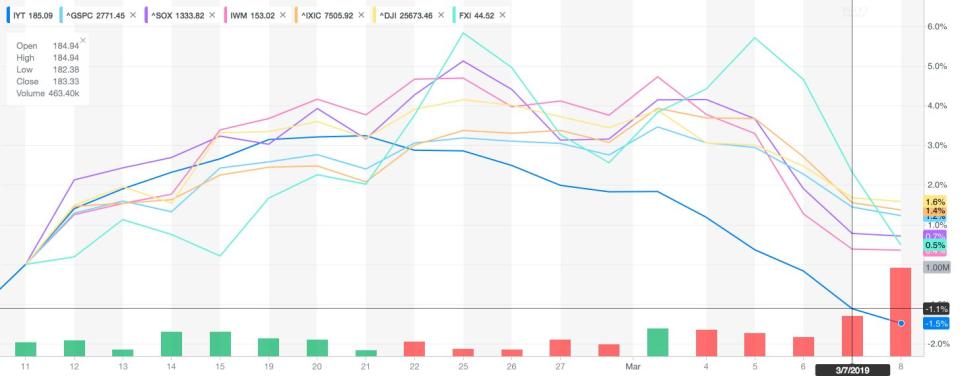The stock market rally is dying, yet again

What, you thought the Dow and S&P 500 were each heading up 50% this year?
Guess again.
After a blistering start to trading in 2019 — paced by big-cap stalwarts such as Boeing (BA), Netflix (NFLX) and Facebook (FB) — the stock market has hit its first rough patch of the year. The Dow Jones Industrial Average, S&P 500 and Nasdaq Composite have each dropped about 2% over the past two weeks. That’s not exactly a rip your face off plunge like the one felt in the fall of 2018, but it’s bothersome given the Federal Reserve has taken another rate hike off the table at least until later in the year (if at all judging by Federal Reserve Chair Jerome Powell’s comments Sunday on “60 Minutes”).
Those algorithm trading programs are supposed to love a friendly Fed, no?
What’s more, leading areas of the market have begun to breakdown. The Dow Transports have fallen roughly 4.5% in two weeks’ time, same goes for the Philadelphia Semiconductor Index and small-cap Russell 2000.
For those hoping the selling subsides, they can be in for a rough go of it in the short-term.
Stocks moved too far, too fast
Investors are back to paying attention to global macroeconomic data after ignoring it in January and February. The bad news here is that said global economic data has borderline stunk of late, calling into question the valuation surge in top names like Boeing and the valuation recovery in struggling dogs such as General Electric (GE).
“Global PMIs, which seem the single-best metric for tracking current momentum and anticipating a pivot, remain a mashup: headline readings still signal a sub-trend expansion; sectoral indices still show huge imbalances between collapsing manufacturing and resilient services; regional indices show less dispersion as Europe stabilizes; and forward-looking indicators conflict as new orders tick up but future output ticks down,” contends JPMorgan strategist John Normand.
Normand is dead on. Here’s what the market has been digesting on the macro data front.. it’s far from pretty.

Terrible 20,000 increase in U.S. non-farm payrolls for February. Wall Street was quick to blame the miss (estimates were for an increase of 180,000) on weather and lingering effects of the government shutdown. But the core of the report suggests a cooling in the U.S. labor market versus 2018 trends. With that comes the prospects for a disappointing read on first quarter U.S. GDP and corporate earnings.
The ECB slashed its 2019 growth outlook to 1.1% from 1.7% and promised to dole out more loans to European Union banks to ignite growth.
China’s exports crashed 20.7% in February thanks to the impact of the trade war with the U.S.
China cut its 2019 growth outlook to 6% to 6.5%.
The Citigroup Global Surprise Index — which measures whether data beats or surpasses forecasts — has fallen below its 2018 low to its weakest level since 2013.
U.S. ISM manufacturing index for February fell month over month and missed consensus estimates. It marked the lowest reading dating back to November 2016.
The ongoing strength of the U.S. dollar is also weighing on markets, according to Jefferies strategist Sean Darby. A resilient dollar could do its part to hurt the earnings of multinational companies in the front half of the year.
When the economic data and the dollar haven’t upset the bulls, negative headlines on the political front have stepped in to pick up the slack. From no signs of a U.S. trade truce with China to impeachment chatter surrounding President Donald Trump amid the Mueller report submission, investors have found new reasons to book profits.
“Impeachment chatter has surged again given imminent delivery of the Mueller report plus this week's House request for documents around various allegations around the President,” points out Normand. “Watch this space – U.S. domestic politics can become as material in 2019/20 as international politics was in 2018.”
Suddenly Boeing trading at a price-to-earnings multiple of 24 times forward estimated profits doesn’t seem that attractive, right?
The bottom line with this selloff
The easy money has been made in this market before the spring season kicks into gear. Credit for that undoubtedly goes to the Federal Reserve — it stoked the rally at a time of deeply oversold conditions after the Christmas Eve massacre. Now, the market knows the “Fed Put” is in place for some time... and may not jolt growth anyway in the first half of 2019.
In turn, for the market rally to resurface the macroeconomic data flow has to improve. That includes flat out good reports where growth accelerates or estimate beats amid lower Wall Street expectations. Indeed, that is unlikely to happen in the short-term, and neither is an overly bullish Corporate America ahead of the first quarter earnings season in April.
The earnings report from economic bellwether FedEx (FDX) on March19 now takes on greater importance.
The saving grace amidst this more volatile backdrop? A full-blown correction/meltdown like the one last fall will probably not happen.
“Current conditions do not look so conducive to a large correction. Valuations and positions look below average rather than extended, even though volatility is below average and global growth still slowing,” says Normand. “Market depth appears high in aggregate, but only because better-than-average conditions in Bonds, Credit and Commodities offset worse-than-average liquidity in Equities. So, while they are mindful of making strong calls about something as imprecise as forecasting drawdown, most ex ante conditions do not resemble those that delivered the shocks of 2015 and 2018.”
Somewhat reassuring, but not totally.
Brian Sozzi is an editor-at-large at Yahoo Finance. Follow him on Twitter @BrianSozzi
Read more:
